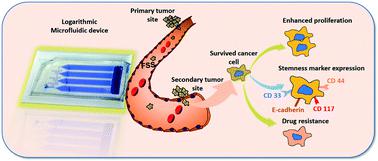Our official English website, www.x-mol.net, welcomes your
feedback! (Note: you will need to create a separate account there.)
Fluid shear stress in a logarithmic microfluidic device enhances cancer cell stemness marker expression
Lab on a Chip ( IF 6.1 ) Pub Date : 2022-05-11 , DOI: 10.1039/d1lc01139a Sanat Kumar Dash 1, 2 , Bamadeb Patra 2 , Vineeta Sharma 2 , Sarit K Das 1 , Rama Shanker Verma 2
Lab on a Chip ( IF 6.1 ) Pub Date : 2022-05-11 , DOI: 10.1039/d1lc01139a Sanat Kumar Dash 1, 2 , Bamadeb Patra 2 , Vineeta Sharma 2 , Sarit K Das 1 , Rama Shanker Verma 2
Affiliation

|
Fluid shear stress (FSS) is crucial in cancer cell survival and tumor development. Noteworthily, cancer cells are exposed to several degrees of FSS in the tumor microenvironment and during metastasis. Consequently, the stemness marker expression in cancer cells changes with the FSS signal, although it is unclear how it varies with different magnitudes and during metastasis. The current work explores the stemness and drug resistance characteristics of the cervical cancer cell line HeLa in a microfluidic device with a wide range of physiological FSS. Hence, the microfluidic device was designed to achieve a logarithmic flow distribution in four culture chambers, realizing four orders of biological shear stress on a single chip. The cell cycle analysis demonstrated altered cell proliferation and mitotic arrest after FSS treatment. In addition, EdU staining revealed increased cell proliferation with medium to low FSS, whereas high shear had a suppressing effect. FSS increased competence to withstand higher intracellular ROS and mitochondrial membrane potential in HeLa. Furthermore, stemness-related gene (Sox2, N-cadherin) and cell surface marker (CD44, CD33, CD117) expressions were enhanced by FSS mechanotransduction in a magnitude-dependent manner. In summary, these stemness-like properties were concurrent with the drug resistance capability of HeLa towards doxorubicin. Overall, our microfluidic device elucidates cancer cell survival and drug resistance mechanisms during metastasis and in cancer relapse patients.
中文翻译:

对数微流体装置中的流体剪切应力增强癌细胞干性标记物的表达
流体剪切应力 (FSS) 在癌细胞存活和肿瘤发展中至关重要。值得注意的是,癌细胞在肿瘤微环境和转移过程中暴露于多种程度的 FSS。因此,癌细胞中的干性标志物表达随 FSS 信号而变化,尽管尚不清楚它如何随不同幅度和转移过程而变化。目前的工作在具有广泛生理 FSS 的微流体装置中探索宫颈癌细胞系 HeLa 的干性和耐药性特征。因此,微流控装置被设计成在四个培养室中实现对数流量分布,在单个芯片上实现四个数量级的生物剪切应力。细胞周期分析表明 FSS 处理后细胞增殖和有丝分裂停滞发生了改变。此外,EdU 染色显示中等至低 FSS 的细胞增殖增加,而高剪切具有抑制作用。FSS 增加了承受 HeLa 中更高的细胞内 ROS 和线粒体膜电位的能力。此外,干性相关基因(Sox2、N-钙粘蛋白)和细胞表面标记(CD44、CD33、CD117)的表达通过 FSS 机械转导以幅度依赖的方式增强。总之,这些类似干性的特性与 HeLa 对多柔比星的耐药能力同时存在。总的来说,我们的微流体装置阐明了癌细胞在转移过程中和癌症复发患者中的存活和耐药机制。FSS 增加了承受 HeLa 中更高的细胞内 ROS 和线粒体膜电位的能力。此外,干性相关基因(Sox2、N-钙粘蛋白)和细胞表面标记(CD44、CD33、CD117)的表达通过 FSS 机械转导以幅度依赖的方式增强。总之,这些类似干性的特性与 HeLa 对多柔比星的耐药能力同时发生。总的来说,我们的微流体装置阐明了癌细胞在转移过程中和癌症复发患者中的存活和耐药机制。FSS 增加了承受 HeLa 中更高的细胞内 ROS 和线粒体膜电位的能力。此外,干性相关基因(Sox2、N-钙粘蛋白)和细胞表面标记(CD44、CD33、CD117)的表达通过 FSS 机械转导以幅度依赖的方式增强。总之,这些类似干性的特性与 HeLa 对多柔比星的耐药能力同时发生。总的来说,我们的微流体装置阐明了癌细胞在转移过程中和癌症复发患者中的存活和耐药机制。这些类似干性的特性与 HeLa 对多柔比星的耐药能力同时发生。总的来说,我们的微流体装置阐明了癌细胞在转移过程中和癌症复发患者中的存活和耐药机制。这些类似干性的特性与 HeLa 对多柔比星的耐药能力同时发生。总的来说,我们的微流体装置阐明了癌细胞在转移过程中和癌症复发患者中的存活和耐药机制。
更新日期:2022-05-11
中文翻译:

对数微流体装置中的流体剪切应力增强癌细胞干性标记物的表达
流体剪切应力 (FSS) 在癌细胞存活和肿瘤发展中至关重要。值得注意的是,癌细胞在肿瘤微环境和转移过程中暴露于多种程度的 FSS。因此,癌细胞中的干性标志物表达随 FSS 信号而变化,尽管尚不清楚它如何随不同幅度和转移过程而变化。目前的工作在具有广泛生理 FSS 的微流体装置中探索宫颈癌细胞系 HeLa 的干性和耐药性特征。因此,微流控装置被设计成在四个培养室中实现对数流量分布,在单个芯片上实现四个数量级的生物剪切应力。细胞周期分析表明 FSS 处理后细胞增殖和有丝分裂停滞发生了改变。此外,EdU 染色显示中等至低 FSS 的细胞增殖增加,而高剪切具有抑制作用。FSS 增加了承受 HeLa 中更高的细胞内 ROS 和线粒体膜电位的能力。此外,干性相关基因(Sox2、N-钙粘蛋白)和细胞表面标记(CD44、CD33、CD117)的表达通过 FSS 机械转导以幅度依赖的方式增强。总之,这些类似干性的特性与 HeLa 对多柔比星的耐药能力同时存在。总的来说,我们的微流体装置阐明了癌细胞在转移过程中和癌症复发患者中的存活和耐药机制。FSS 增加了承受 HeLa 中更高的细胞内 ROS 和线粒体膜电位的能力。此外,干性相关基因(Sox2、N-钙粘蛋白)和细胞表面标记(CD44、CD33、CD117)的表达通过 FSS 机械转导以幅度依赖的方式增强。总之,这些类似干性的特性与 HeLa 对多柔比星的耐药能力同时发生。总的来说,我们的微流体装置阐明了癌细胞在转移过程中和癌症复发患者中的存活和耐药机制。FSS 增加了承受 HeLa 中更高的细胞内 ROS 和线粒体膜电位的能力。此外,干性相关基因(Sox2、N-钙粘蛋白)和细胞表面标记(CD44、CD33、CD117)的表达通过 FSS 机械转导以幅度依赖的方式增强。总之,这些类似干性的特性与 HeLa 对多柔比星的耐药能力同时发生。总的来说,我们的微流体装置阐明了癌细胞在转移过程中和癌症复发患者中的存活和耐药机制。这些类似干性的特性与 HeLa 对多柔比星的耐药能力同时发生。总的来说,我们的微流体装置阐明了癌细胞在转移过程中和癌症复发患者中的存活和耐药机制。这些类似干性的特性与 HeLa 对多柔比星的耐药能力同时发生。总的来说,我们的微流体装置阐明了癌细胞在转移过程中和癌症复发患者中的存活和耐药机制。









































 京公网安备 11010802027423号
京公网安备 11010802027423号